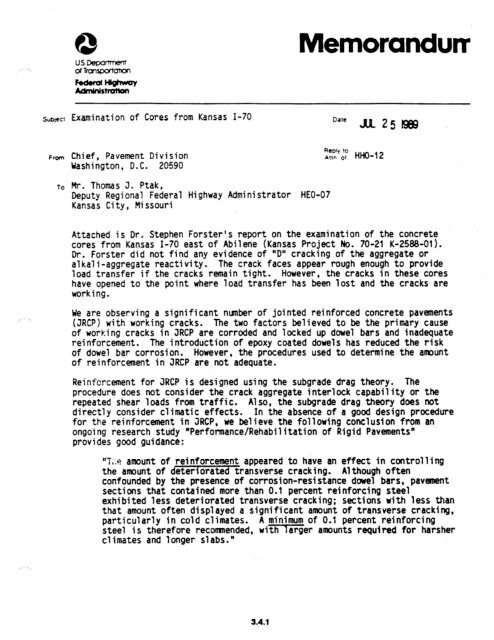chapter 3 rigid pavement - DOT On-Line Publications - Department ...
chapter 3 rigid pavement - DOT On-Line Publications - Department ...
chapter 3 rigid pavement - DOT On-Line Publications - Department ...
Create successful ePaper yourself
Turn your PDF publications into a flip-book with our unique Google optimized e-Paper software.
sublect Examination of Cores from Kansas I-70<br />
Ffm Chief, Pavement Division<br />
Uashington, D.C. 20590<br />
lo Mr. Thomas 3. Ptak,<br />
Deputy Regional Federal Highway Administrator HEO-07<br />
Kansas City, Missouri<br />
Da’e AL 2 5 1969<br />
Attached is Dr. Stephen Forster's report on the examination of the concrete<br />
cores from Kansas I-70 east of Abilene (Kansas Project No. 70-21 K-2588-01).<br />
Dr. Forster did not find any evidence of "D" cracking of the aggregate or<br />
alkali-aggregate reactivity. The crack faces appear rough enough to provide<br />
load transfer if the cracks remain tight. However, the cracks in these cores<br />
have opened to the point where load transfer has been 1 ost and the cracks are<br />
working.<br />
We are observing a significant number of jointed reinforced concrete <strong>pavement</strong>s<br />
(JRCP) with working cracks. The two factors believed to be the primary cause<br />
of working cracks in JRCP are corroded and locked up dowel bars and inadequate<br />
reinforcement. The introduction of epoxy coated dowels has reduced the risk<br />
of dowel bar corrosion. However, the procedures used to determine the amount<br />
of reinforcement in JRCP are not adequate.<br />
Reinforcement for JRCP is designed using the subgrade drag theory. The<br />
procedure does not consider the crack aggregate interlock capability or the<br />
repeated shear loads from traffic. Also, the subgrade drag theory does not<br />
directly consider climatic effects. In the absence of a good design procedure<br />
for the reinforcement in JRCP, we believe the following conclusion from an<br />
ongoing research study "Performance/Rehabilitation of Rigid Pavements"<br />
provides good guidance:<br />
nT;:, amount of reinforcement appeared to have an effect in controlling<br />
the amount of deteriorated transverse cracking. Although often<br />
confounded by the presence of corrosion-resistance dowel bars, <strong>pavement</strong><br />
sections that contained more than 0.1 percent reinforcing steel<br />
exhibited less deteriorated transverse cracking; sections with less than<br />
that amount often displayed a significant amount of transverse cracking,<br />
particularly in cold climates. A minimum of 0.1 percent reinforcing<br />
steel is therefore reconmtended, wither amounts required for harsher<br />
climates and longer slabs."<br />
3.4.1
















